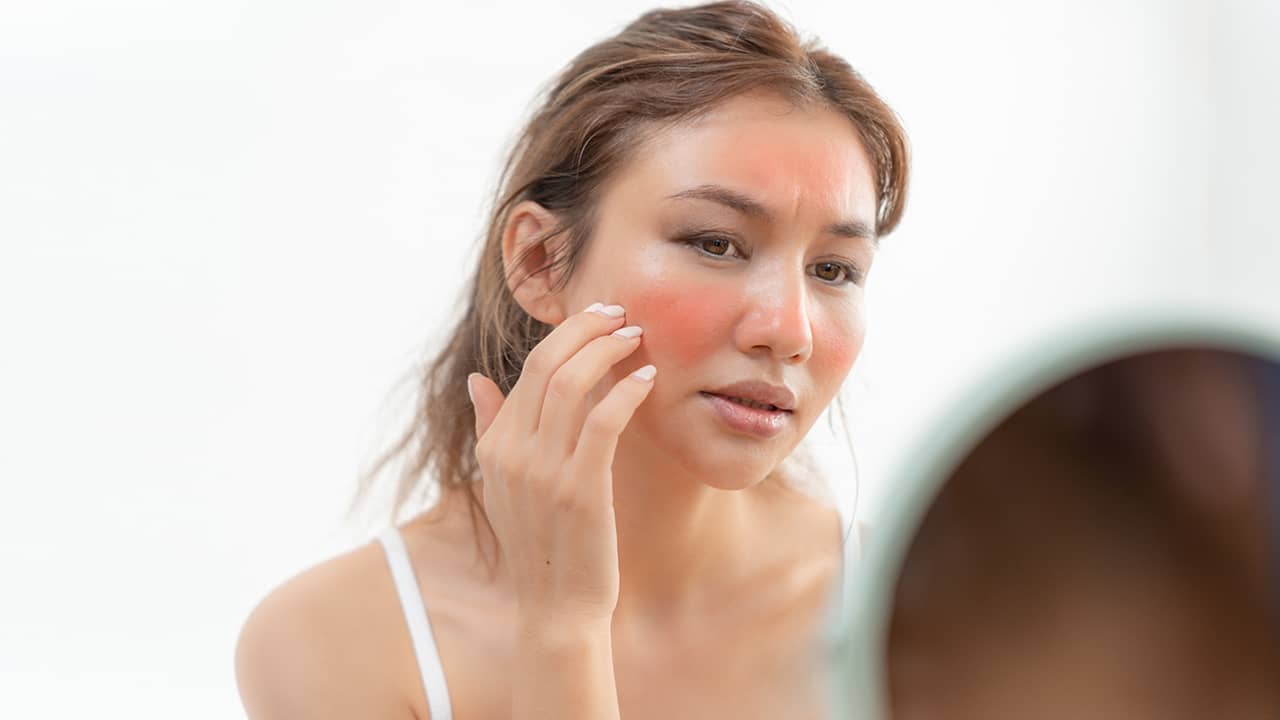It’s a story we all know too well: if you have sensitive skin, exfoliation can feel like an impossible mission. A scrub that’s a bit too harsh or an acid that’s too strong, and you’re left with redness, irritation, and discomfort. But our team of experts is here to tell you that it is absolutely possible to get that smooth, bright complexion you’ve been dreaming of, even with reactive skin!
We’ve put together this comprehensive guide to prove that peels are not the enemy of sensitive skin. We’re going to share our best advice, tell you about the ingredients we absolutely love, and, most importantly, reveal our top 5 favorite products for a truly radiant result.
In this article :
What is Peeling for Sensitive Skin?
Our Favorite Ingredients for an Effective, Safe Peel
Types of peels for sensitive skin
Benefits of chemical peels for sensitive skin
Risks and potential side effects
Precautions for sensitive skin peel
Pre- and post-peel care tips
Who is a good candidate for sensitive skin peeling ?
Sensitive skin peeling vs. other exfoliation methods
Top 5 peeling products for sensitive skin
Frequently asked questions (FAQ)
What is sensitive skin peeling ?
For us, a gentle peel is the perfect answer to the whims of sensitive skin. Instead of relying on harsh, abrasive ingredients, it uses ultra-gentle exfoliants designed to remove dead skin cells while protecting your skin’s natural barrier. The whole idea is to give your skin a deep clean without attacking it, allowing it to breathe, calm down, and regain its glow.
Our Favorite Ingredients for an Effective, Safe Peel
We only stand by ingredients that work gently. Think of them as our skincare superheroes for delicate skin :
- Lactic acid (AHA): This is an incredibly gentle exfoliant, perfect for sensitive skin. What makes it special? It hydrates the skin at the same time it removes dead skin cells. We love it!
- Mandelic acid (AHA): It has a larger molecular structure than other AHAs, which means it doesn’t penetrate as deeply and acts even more gently. It’s the perfect ally for reactive skin.
- Poly-hydroxy acids (PHAs): Think of these as next-generation exfoliants. They are so gentle that they are even suitable for skin prone to rosacea. An added bonus: they also provide deep hydration.
- Fruit Enzymes (papaya, pumpkin): Enzymes from papaya or pumpkin, for example, are natural exfoliants that delicately dissolve dead skin cells without any physical abrasion. A true treat for extremely sensitive skin.
These ingredients work together to promote cell turnover, improve skin texture, and brighten the complexion without compromising the skin’s natural barrier.
Benefits of A peel for YOUR skin
When you finally find the right product, the results are truly amazing. Not only will your complexion be more luminous, but you’ll notice a real difference in these areas:
- Enhances skin texture: No more rough, dry patches. Your skin will feel smoother and softer to the touch.
- Brightens complexion: By removing dead cells, you reveal fresh, new skin for a complexion that’s brighter than ever.
- Improves product absorption: After a gentle peel, your skin is ready to soak up all the benefits of your serums and moisturizers.
Top 5 peeling products for sensitive skin
- The Ordinary lactic acid 5% + HA
- Key ingredients: Lactic acid, hyaluronic acid.
- Benefits: Gentle exfoliation with added hydration.
- How to use: Apply in the evening, 1-2 times a week.
- Safety tips: Use sunscreen daily after application.
- REN Ready Steady Glow daily AHA tonic
- Key ingredients: Lactic acid, azelaic acid.
- Benefits: Brightens and smooths the skin with minimal irritation.
- How to use: Swipe over clean skin with a cotton pad.
- Safety tips: Avoid using with other exfoliants.
- First Aid Beauty facial radiance pads
- Key ingredients: Lactic acid, glycolic acid.
- Benefits: Gentle exfoliation suitable for daily use.
- How to use: Swipe one pad across the face after cleansing.
- Safety tips: Introduce gradually to monitor skin response.
- Paula’s Choice PHA 4% treatment
- Key ingredients: Gluconolactone (PHA), chamomile extract.
- Benefits: Hydrates while gently exfoliating.
- How to use: Apply after cleansing, 2-3 times a week.
- Safety tips: Ideal for reactive skin types.
- Dermalogica daily microfoliant
- Key ingredients: Rice enzymes, salicylic acid (low concentration).
- Benefits: Gentle powder exfoliant that activates with water.
- How to use: Dispense into wet hands, create a paste, and massage gently.
- Safety tips: Safe for daily use, even on sensitive skin.
Risks and potential side effects
Even gentle peels can cause issues if not used properly:
- Redness or flushing: Temporary but can be prolonged with strong formulas.
- Dryness or tightness: Over-exfoliation can disrupt the skin barrier.
- Stinging or burning: May occur if applied to compromised skin.
Precautions for sensitive skin peel
- Perform a patch test before full application.
- Avoid exfoliating more than 1-2 times per week.
- Use fragrance-free, hypoallergenic products post-peel.
Pre- and post-peel care tips
Before the peel:
- Stop using retinoids, strong exfoliants, or alcohol-based treatments a week prior.
- Keep the skin moisturized and avoid sun exposure.
During the peel:
- Apply a thin, even layer of the peel.
- Leave it on for the recommended time (usually 5-10 minutes).
- Rinse thoroughly with lukewarm water.
Aftercare:
- Apply a soothing moisturizer with ceramides or aloe vera.
- Use broad-spectrum sunscreen daily to protect the skin.
- Avoid harsh skincare products for at least 48 hours post-peel.
Who is a good candidate for sensitive skin peeling ?
Ideal candidates:
- Those with dullness, uneven texture, mild hyperpigmentation, or clogged pores.
Contraindications:
- Active eczema, rosacea flare-ups, open wounds, or compromised skin barriers.
- Always consult a dermatologist if unsure.
Sensitive skin peeling vs. other exfoliation methods
- Chemical peels vs. physical exfoliants: Chemical peels are less abrasive, reducing the risk of micro-tears.
- Peels vs. scrubs: Peels are more controlled and consistent, while scrubs can be harsh.
- Peels vs. microdermabrasion: Microdermabrasion is too abrasive for sensitive skin, whereas peels can be tailored for gentleness.
Frequently asked questions (FAQ)
Gentle peels with PHAs (polyhydroxy acids), lactic acid, or enzyme-based formulas are ideal for sensitive skin.
Keep your skin hydrated, avoid retinoids or exfoliants 48 hours before, and do a patch test to check for reactions.
Yes, applying a fragrance-free, soothing moisturizer helps restore hydration and calm the skin after a peel.
Recovery usually takes 3–7 days, depending on the peel’s strength and your skin’s sensitivity.
Severe redness, blistering, intense burning, or prolonged irritation may indicate an adverse reaction—seek medical advice if this occurs.
It’s best to wait at least 24 hours or until any redness subsides to avoid further irritation. Choose non-comedogenic, gentle products when you do.
1-2 times per week, depending on the product and your skin’s tolerance.
Yes, if the peel is formulated for sensitive skin with gentle ingredients like PHAs.
Avoid retinoids, strong acids, scrubs, and direct sun exposure.
Mild tingling is normal, but burning or severe discomfort is not. Rinse immediately if this occurs.
Overuse or strong formulas can increase sensitivity. Always follow product instructions.
final thoughts
Sensitive skin doesn’t mean you have to skip exfoliation. With the right gentle peels and proper aftercare, you can enjoy smoother, brighter skin without discomfort. Whether you prefer enzyme-based products or mild acids like PHAs, there’s a peel tailored for your delicate skin. Start slow, stay consistent, and always listen to your skin’s needs.ce. brighter, and healthier skin. Give it a try and experience the difference for yourself!.
What to read next


